University Essay: Enterprise Systems Drivers, Performance, Adoption
VerifiedAdded on 2023/01/20
|9
|2311
|45
Report
AI Summary
This report delves into the realm of Enterprise Systems, analyzing the principal drivers that propel businesses to adopt them, including organizational size, IT maturity, and global reach. It explores the contributions of Enterprise Systems like ERP and CRM to organizational performance, examining how they streamline processes, enhance information sharing, and improve decision-making. The report also discusses the measurement of these contributions, emphasizing the impact on procurement efficiency and overall profitability. Furthermore, it highlights two critical organizational change management considerations for successful Enterprise System adoption: cost minimization and product differentiation. The essay concludes by underscoring the importance of Enterprise Systems in improving business processes and workflows, making them a vital tool for companies seeking to enhance customer service and operational efficiency.

Running head: MANAGEMENT
Business Communication
Name of the Student:
Name of the University:
Author Note:
Business Communication
Name of the Student:
Name of the University:
Author Note:
Paraphrase This Document
Need a fresh take? Get an instant paraphrase of this document with our AI Paraphraser
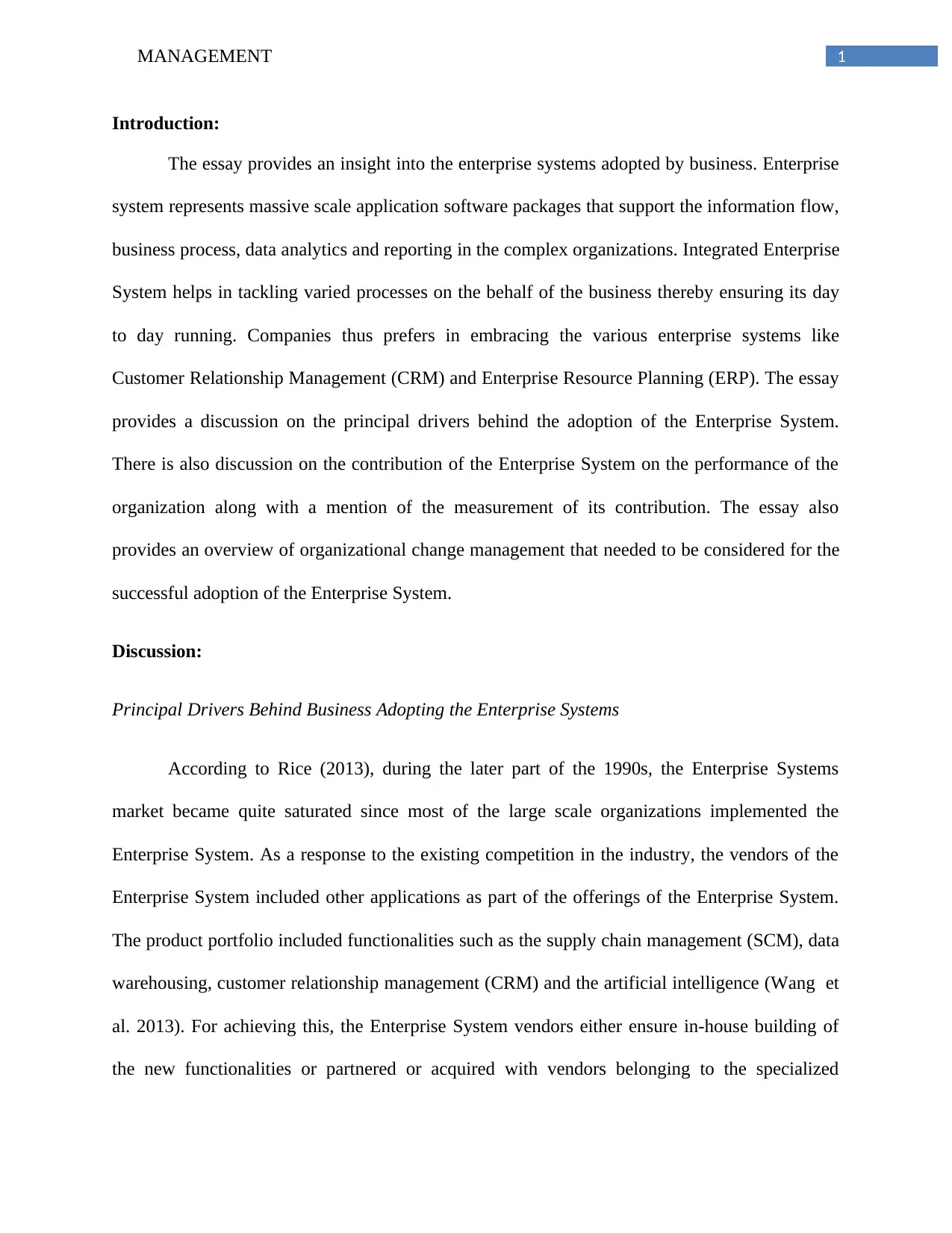
1MANAGEMENT
Introduction:
The essay provides an insight into the enterprise systems adopted by business. Enterprise
system represents massive scale application software packages that support the information flow,
business process, data analytics and reporting in the complex organizations. Integrated Enterprise
System helps in tackling varied processes on the behalf of the business thereby ensuring its day
to day running. Companies thus prefers in embracing the various enterprise systems like
Customer Relationship Management (CRM) and Enterprise Resource Planning (ERP). The essay
provides a discussion on the principal drivers behind the adoption of the Enterprise System.
There is also discussion on the contribution of the Enterprise System on the performance of the
organization along with a mention of the measurement of its contribution. The essay also
provides an overview of organizational change management that needed to be considered for the
successful adoption of the Enterprise System.
Discussion:
Principal Drivers Behind Business Adopting the Enterprise Systems
According to Rice (2013), during the later part of the 1990s, the Enterprise Systems
market became quite saturated since most of the large scale organizations implemented the
Enterprise System. As a response to the existing competition in the industry, the vendors of the
Enterprise System included other applications as part of the offerings of the Enterprise System.
The product portfolio included functionalities such as the supply chain management (SCM), data
warehousing, customer relationship management (CRM) and the artificial intelligence (Wang et
al. 2013). For achieving this, the Enterprise System vendors either ensure in-house building of
the new functionalities or partnered or acquired with vendors belonging to the specialized
Introduction:
The essay provides an insight into the enterprise systems adopted by business. Enterprise
system represents massive scale application software packages that support the information flow,
business process, data analytics and reporting in the complex organizations. Integrated Enterprise
System helps in tackling varied processes on the behalf of the business thereby ensuring its day
to day running. Companies thus prefers in embracing the various enterprise systems like
Customer Relationship Management (CRM) and Enterprise Resource Planning (ERP). The essay
provides a discussion on the principal drivers behind the adoption of the Enterprise System.
There is also discussion on the contribution of the Enterprise System on the performance of the
organization along with a mention of the measurement of its contribution. The essay also
provides an overview of organizational change management that needed to be considered for the
successful adoption of the Enterprise System.
Discussion:
Principal Drivers Behind Business Adopting the Enterprise Systems
According to Rice (2013), during the later part of the 1990s, the Enterprise Systems
market became quite saturated since most of the large scale organizations implemented the
Enterprise System. As a response to the existing competition in the industry, the vendors of the
Enterprise System included other applications as part of the offerings of the Enterprise System.
The product portfolio included functionalities such as the supply chain management (SCM), data
warehousing, customer relationship management (CRM) and the artificial intelligence (Wang et
al. 2013). For achieving this, the Enterprise System vendors either ensure in-house building of
the new functionalities or partnered or acquired with vendors belonging to the specialized
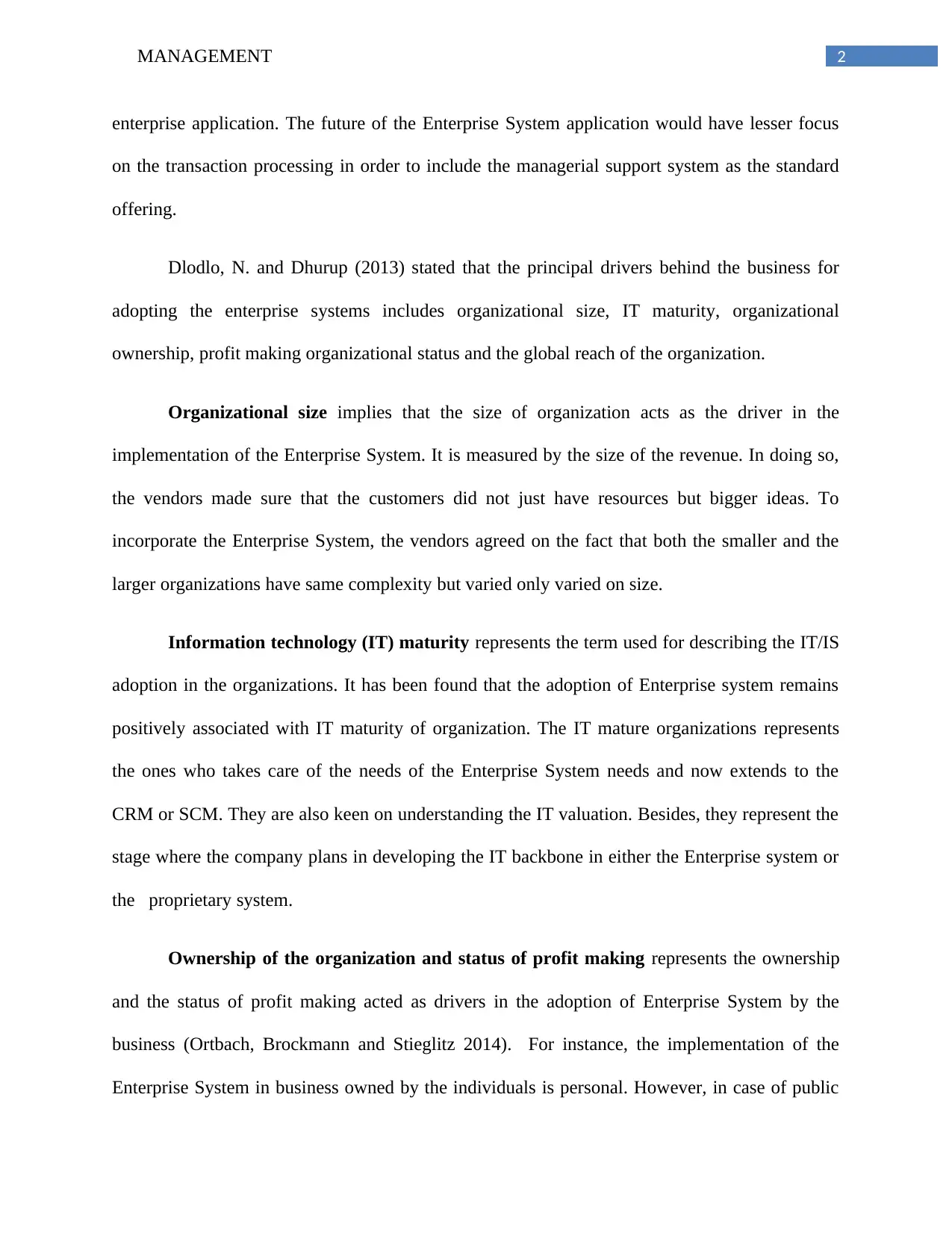
2MANAGEMENT
enterprise application. The future of the Enterprise System application would have lesser focus
on the transaction processing in order to include the managerial support system as the standard
offering.
Dlodlo, N. and Dhurup (2013) stated that the principal drivers behind the business for
adopting the enterprise systems includes organizational size, IT maturity, organizational
ownership, profit making organizational status and the global reach of the organization.
Organizational size implies that the size of organization acts as the driver in the
implementation of the Enterprise System. It is measured by the size of the revenue. In doing so,
the vendors made sure that the customers did not just have resources but bigger ideas. To
incorporate the Enterprise System, the vendors agreed on the fact that both the smaller and the
larger organizations have same complexity but varied only varied on size.
Information technology (IT) maturity represents the term used for describing the IT/IS
adoption in the organizations. It has been found that the adoption of Enterprise system remains
positively associated with IT maturity of organization. The IT mature organizations represents
the ones who takes care of the needs of the Enterprise System needs and now extends to the
CRM or SCM. They are also keen on understanding the IT valuation. Besides, they represent the
stage where the company plans in developing the IT backbone in either the Enterprise system or
the proprietary system.
Ownership of the organization and status of profit making represents the ownership
and the status of profit making acted as drivers in the adoption of Enterprise System by the
business (Ortbach, Brockmann and Stieglitz 2014). For instance, the implementation of the
Enterprise System in business owned by the individuals is personal. However, in case of public
enterprise application. The future of the Enterprise System application would have lesser focus
on the transaction processing in order to include the managerial support system as the standard
offering.
Dlodlo, N. and Dhurup (2013) stated that the principal drivers behind the business for
adopting the enterprise systems includes organizational size, IT maturity, organizational
ownership, profit making organizational status and the global reach of the organization.
Organizational size implies that the size of organization acts as the driver in the
implementation of the Enterprise System. It is measured by the size of the revenue. In doing so,
the vendors made sure that the customers did not just have resources but bigger ideas. To
incorporate the Enterprise System, the vendors agreed on the fact that both the smaller and the
larger organizations have same complexity but varied only varied on size.
Information technology (IT) maturity represents the term used for describing the IT/IS
adoption in the organizations. It has been found that the adoption of Enterprise system remains
positively associated with IT maturity of organization. The IT mature organizations represents
the ones who takes care of the needs of the Enterprise System needs and now extends to the
CRM or SCM. They are also keen on understanding the IT valuation. Besides, they represent the
stage where the company plans in developing the IT backbone in either the Enterprise system or
the proprietary system.
Ownership of the organization and status of profit making represents the ownership
and the status of profit making acted as drivers in the adoption of Enterprise System by the
business (Ortbach, Brockmann and Stieglitz 2014). For instance, the implementation of the
Enterprise System in business owned by the individuals is personal. However, in case of public
⊘ This is a preview!⊘
Do you want full access?
Subscribe today to unlock all pages.

Trusted by 1+ million students worldwide
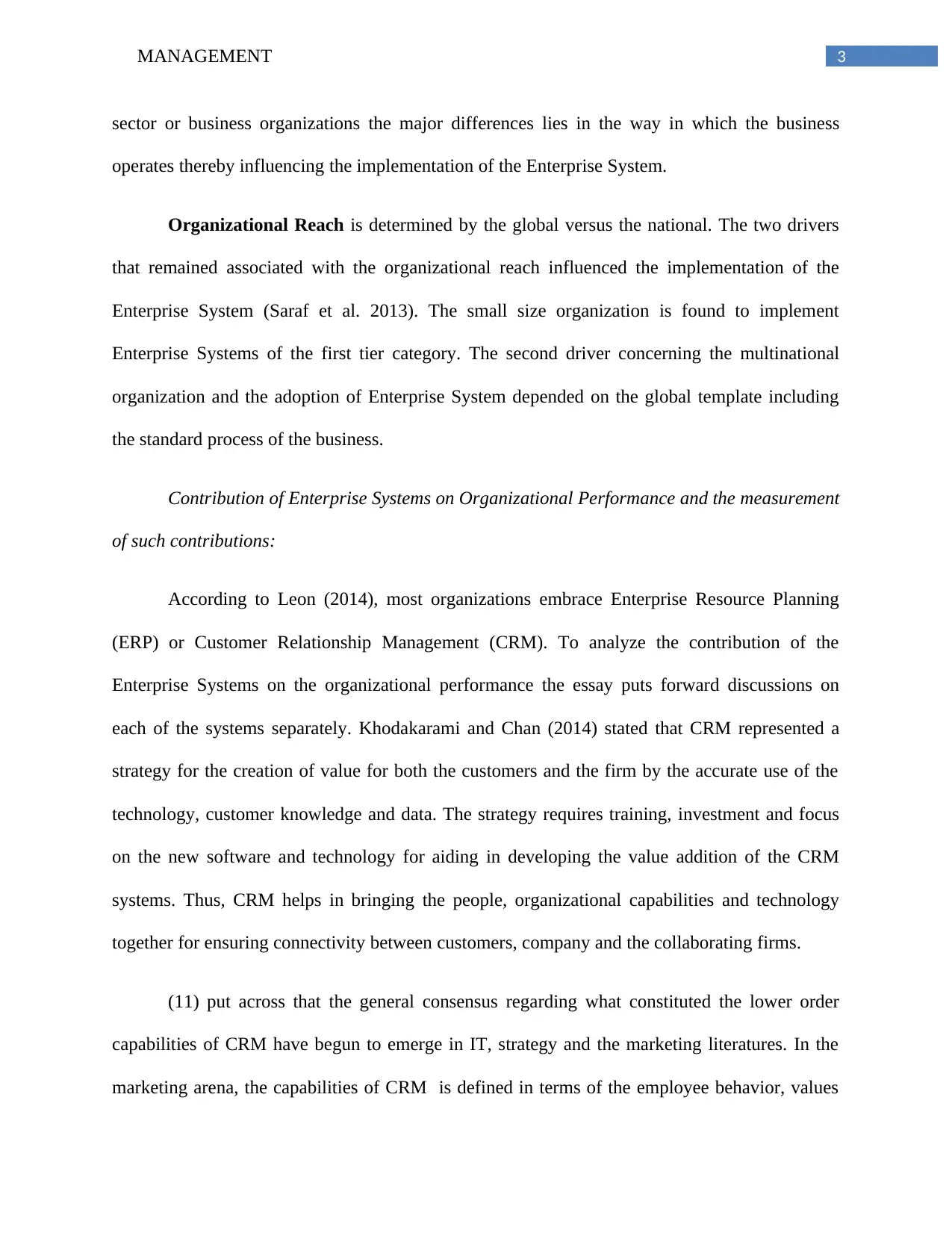
3MANAGEMENT
sector or business organizations the major differences lies in the way in which the business
operates thereby influencing the implementation of the Enterprise System.
Organizational Reach is determined by the global versus the national. The two drivers
that remained associated with the organizational reach influenced the implementation of the
Enterprise System (Saraf et al. 2013). The small size organization is found to implement
Enterprise Systems of the first tier category. The second driver concerning the multinational
organization and the adoption of Enterprise System depended on the global template including
the standard process of the business.
Contribution of Enterprise Systems on Organizational Performance and the measurement
of such contributions:
According to Leon (2014), most organizations embrace Enterprise Resource Planning
(ERP) or Customer Relationship Management (CRM). To analyze the contribution of the
Enterprise Systems on the organizational performance the essay puts forward discussions on
each of the systems separately. Khodakarami and Chan (2014) stated that CRM represented a
strategy for the creation of value for both the customers and the firm by the accurate use of the
technology, customer knowledge and data. The strategy requires training, investment and focus
on the new software and technology for aiding in developing the value addition of the CRM
systems. Thus, CRM helps in bringing the people, organizational capabilities and technology
together for ensuring connectivity between customers, company and the collaborating firms.
(11) put across that the general consensus regarding what constituted the lower order
capabilities of CRM have begun to emerge in IT, strategy and the marketing literatures. In the
marketing arena, the capabilities of CRM is defined in terms of the employee behavior, values
sector or business organizations the major differences lies in the way in which the business
operates thereby influencing the implementation of the Enterprise System.
Organizational Reach is determined by the global versus the national. The two drivers
that remained associated with the organizational reach influenced the implementation of the
Enterprise System (Saraf et al. 2013). The small size organization is found to implement
Enterprise Systems of the first tier category. The second driver concerning the multinational
organization and the adoption of Enterprise System depended on the global template including
the standard process of the business.
Contribution of Enterprise Systems on Organizational Performance and the measurement
of such contributions:
According to Leon (2014), most organizations embrace Enterprise Resource Planning
(ERP) or Customer Relationship Management (CRM). To analyze the contribution of the
Enterprise Systems on the organizational performance the essay puts forward discussions on
each of the systems separately. Khodakarami and Chan (2014) stated that CRM represented a
strategy for the creation of value for both the customers and the firm by the accurate use of the
technology, customer knowledge and data. The strategy requires training, investment and focus
on the new software and technology for aiding in developing the value addition of the CRM
systems. Thus, CRM helps in bringing the people, organizational capabilities and technology
together for ensuring connectivity between customers, company and the collaborating firms.
(11) put across that the general consensus regarding what constituted the lower order
capabilities of CRM have begun to emerge in IT, strategy and the marketing literatures. In the
marketing arena, the capabilities of CRM is defined in terms of the employee behavior, values
Paraphrase This Document
Need a fresh take? Get an instant paraphrase of this document with our AI Paraphraser
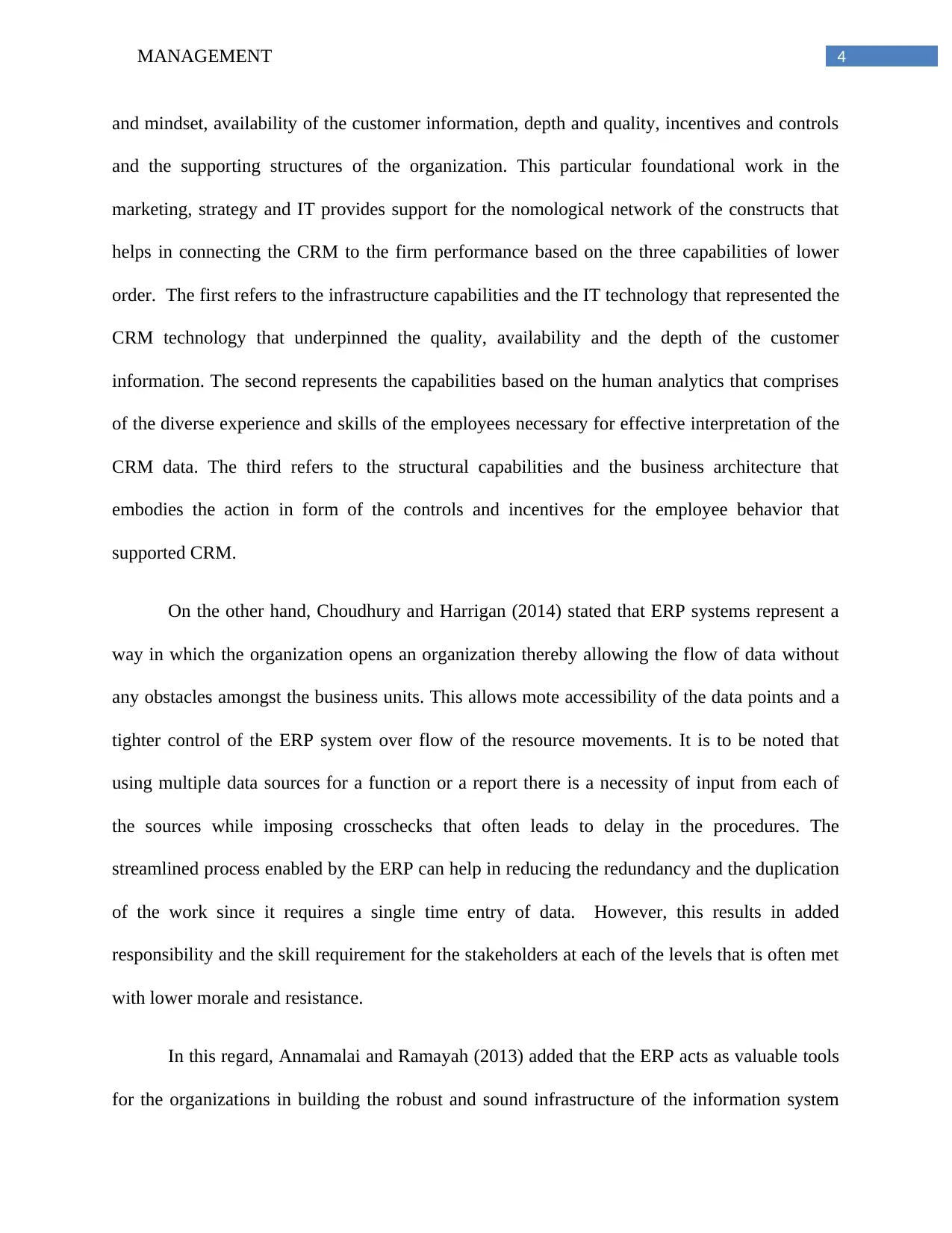
4MANAGEMENT
and mindset, availability of the customer information, depth and quality, incentives and controls
and the supporting structures of the organization. This particular foundational work in the
marketing, strategy and IT provides support for the nomological network of the constructs that
helps in connecting the CRM to the firm performance based on the three capabilities of lower
order. The first refers to the infrastructure capabilities and the IT technology that represented the
CRM technology that underpinned the quality, availability and the depth of the customer
information. The second represents the capabilities based on the human analytics that comprises
of the diverse experience and skills of the employees necessary for effective interpretation of the
CRM data. The third refers to the structural capabilities and the business architecture that
embodies the action in form of the controls and incentives for the employee behavior that
supported CRM.
On the other hand, Choudhury and Harrigan (2014) stated that ERP systems represent a
way in which the organization opens an organization thereby allowing the flow of data without
any obstacles amongst the business units. This allows mote accessibility of the data points and a
tighter control of the ERP system over flow of the resource movements. It is to be noted that
using multiple data sources for a function or a report there is a necessity of input from each of
the sources while imposing crosschecks that often leads to delay in the procedures. The
streamlined process enabled by the ERP can help in reducing the redundancy and the duplication
of the work since it requires a single time entry of data. However, this results in added
responsibility and the skill requirement for the stakeholders at each of the levels that is often met
with lower morale and resistance.
In this regard, Annamalai and Ramayah (2013) added that the ERP acts as valuable tools
for the organizations in building the robust and sound infrastructure of the information system
and mindset, availability of the customer information, depth and quality, incentives and controls
and the supporting structures of the organization. This particular foundational work in the
marketing, strategy and IT provides support for the nomological network of the constructs that
helps in connecting the CRM to the firm performance based on the three capabilities of lower
order. The first refers to the infrastructure capabilities and the IT technology that represented the
CRM technology that underpinned the quality, availability and the depth of the customer
information. The second represents the capabilities based on the human analytics that comprises
of the diverse experience and skills of the employees necessary for effective interpretation of the
CRM data. The third refers to the structural capabilities and the business architecture that
embodies the action in form of the controls and incentives for the employee behavior that
supported CRM.
On the other hand, Choudhury and Harrigan (2014) stated that ERP systems represent a
way in which the organization opens an organization thereby allowing the flow of data without
any obstacles amongst the business units. This allows mote accessibility of the data points and a
tighter control of the ERP system over flow of the resource movements. It is to be noted that
using multiple data sources for a function or a report there is a necessity of input from each of
the sources while imposing crosschecks that often leads to delay in the procedures. The
streamlined process enabled by the ERP can help in reducing the redundancy and the duplication
of the work since it requires a single time entry of data. However, this results in added
responsibility and the skill requirement for the stakeholders at each of the levels that is often met
with lower morale and resistance.
In this regard, Annamalai and Ramayah (2013) added that the ERP acts as valuable tools
for the organizations in building the robust and sound infrastructure of the information system
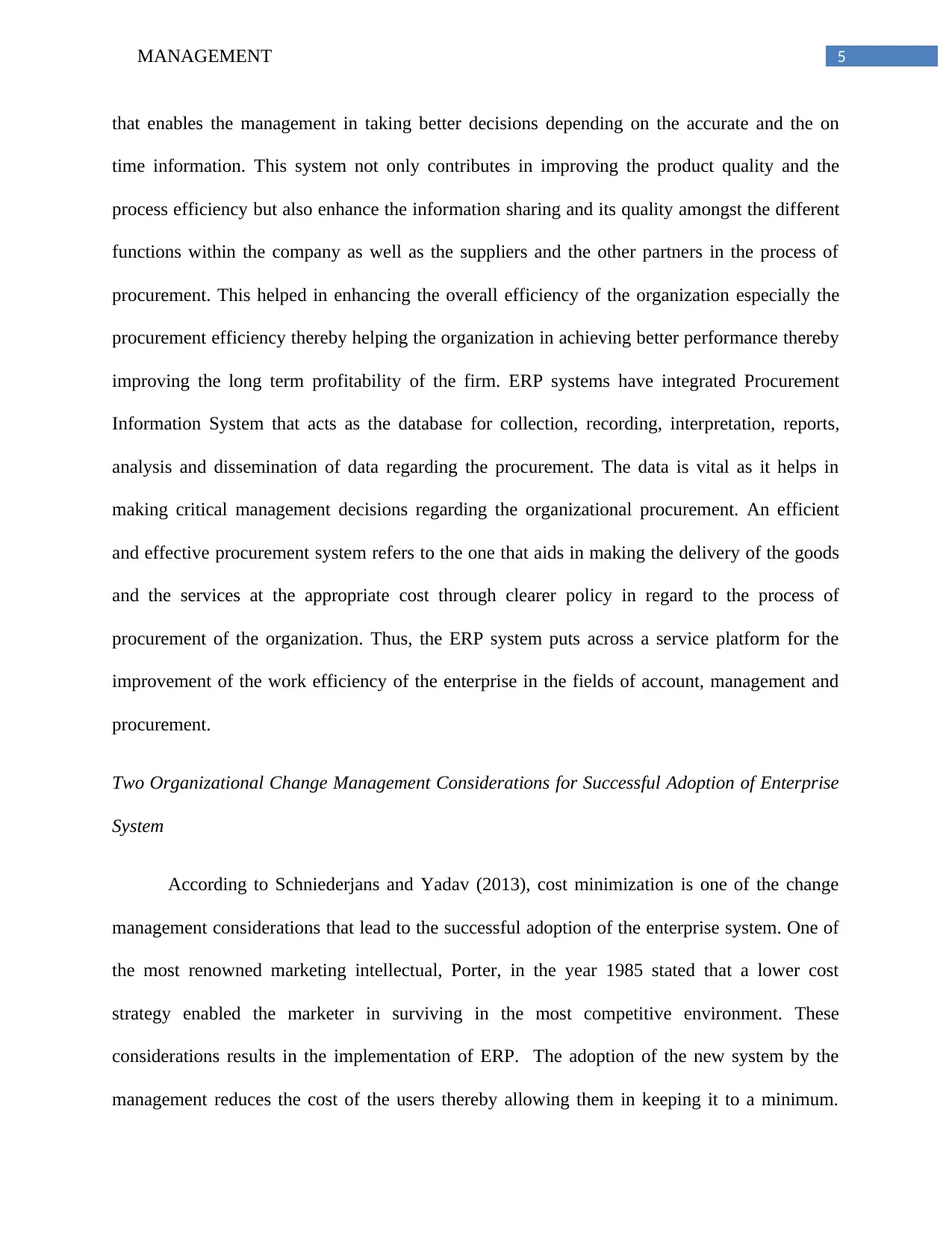
5MANAGEMENT
that enables the management in taking better decisions depending on the accurate and the on
time information. This system not only contributes in improving the product quality and the
process efficiency but also enhance the information sharing and its quality amongst the different
functions within the company as well as the suppliers and the other partners in the process of
procurement. This helped in enhancing the overall efficiency of the organization especially the
procurement efficiency thereby helping the organization in achieving better performance thereby
improving the long term profitability of the firm. ERP systems have integrated Procurement
Information System that acts as the database for collection, recording, interpretation, reports,
analysis and dissemination of data regarding the procurement. The data is vital as it helps in
making critical management decisions regarding the organizational procurement. An efficient
and effective procurement system refers to the one that aids in making the delivery of the goods
and the services at the appropriate cost through clearer policy in regard to the process of
procurement of the organization. Thus, the ERP system puts across a service platform for the
improvement of the work efficiency of the enterprise in the fields of account, management and
procurement.
Two Organizational Change Management Considerations for Successful Adoption of Enterprise
System
According to Schniederjans and Yadav (2013), cost minimization is one of the change
management considerations that lead to the successful adoption of the enterprise system. One of
the most renowned marketing intellectual, Porter, in the year 1985 stated that a lower cost
strategy enabled the marketer in surviving in the most competitive environment. These
considerations results in the implementation of ERP. The adoption of the new system by the
management reduces the cost of the users thereby allowing them in keeping it to a minimum.
that enables the management in taking better decisions depending on the accurate and the on
time information. This system not only contributes in improving the product quality and the
process efficiency but also enhance the information sharing and its quality amongst the different
functions within the company as well as the suppliers and the other partners in the process of
procurement. This helped in enhancing the overall efficiency of the organization especially the
procurement efficiency thereby helping the organization in achieving better performance thereby
improving the long term profitability of the firm. ERP systems have integrated Procurement
Information System that acts as the database for collection, recording, interpretation, reports,
analysis and dissemination of data regarding the procurement. The data is vital as it helps in
making critical management decisions regarding the organizational procurement. An efficient
and effective procurement system refers to the one that aids in making the delivery of the goods
and the services at the appropriate cost through clearer policy in regard to the process of
procurement of the organization. Thus, the ERP system puts across a service platform for the
improvement of the work efficiency of the enterprise in the fields of account, management and
procurement.
Two Organizational Change Management Considerations for Successful Adoption of Enterprise
System
According to Schniederjans and Yadav (2013), cost minimization is one of the change
management considerations that lead to the successful adoption of the enterprise system. One of
the most renowned marketing intellectual, Porter, in the year 1985 stated that a lower cost
strategy enabled the marketer in surviving in the most competitive environment. These
considerations results in the implementation of ERP. The adoption of the new system by the
management reduces the cost of the users thereby allowing them in keeping it to a minimum.
⊘ This is a preview!⊘
Do you want full access?
Subscribe today to unlock all pages.

Trusted by 1+ million students worldwide
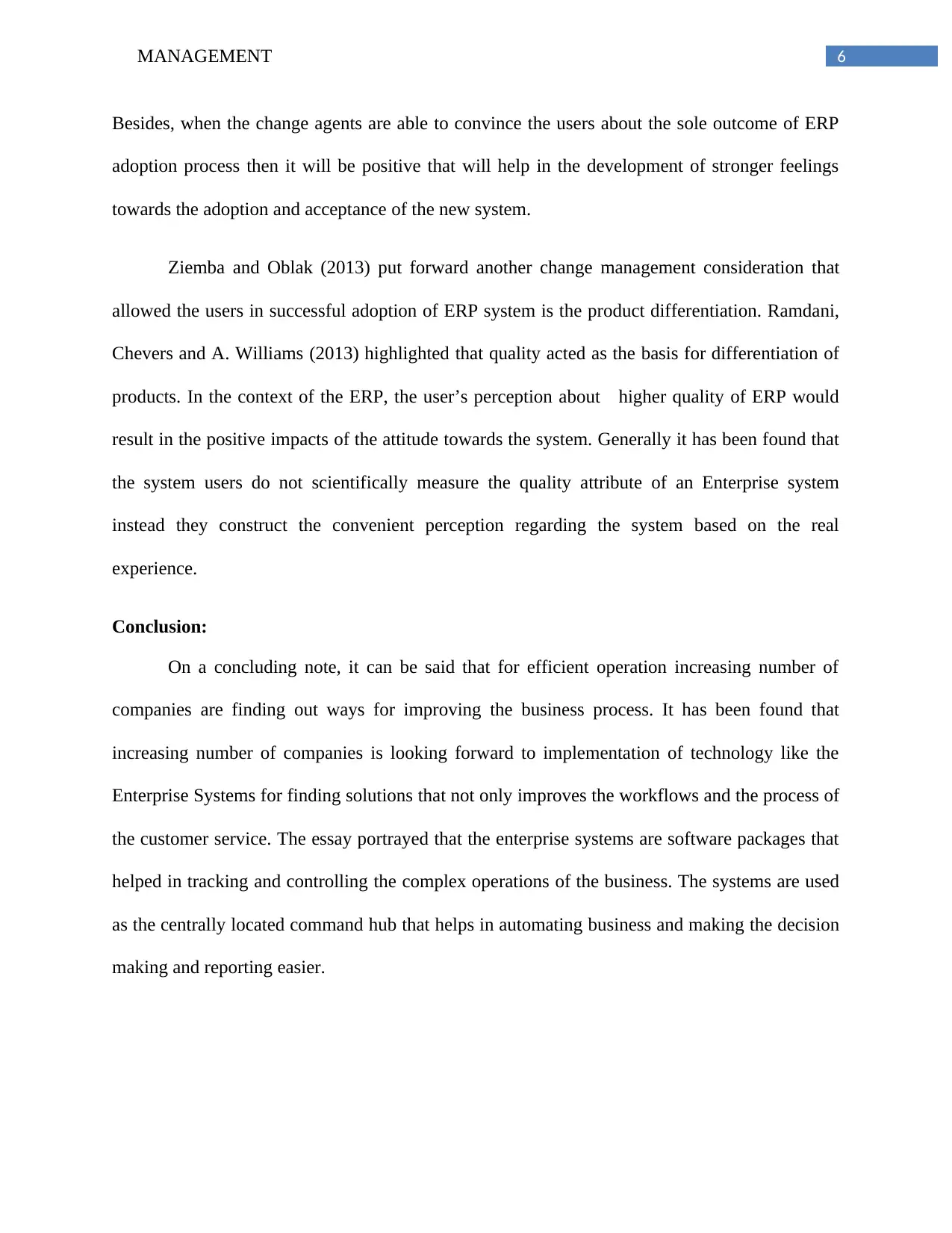
6MANAGEMENT
Besides, when the change agents are able to convince the users about the sole outcome of ERP
adoption process then it will be positive that will help in the development of stronger feelings
towards the adoption and acceptance of the new system.
Ziemba and Oblak (2013) put forward another change management consideration that
allowed the users in successful adoption of ERP system is the product differentiation. Ramdani,
Chevers and A. Williams (2013) highlighted that quality acted as the basis for differentiation of
products. In the context of the ERP, the user’s perception about higher quality of ERP would
result in the positive impacts of the attitude towards the system. Generally it has been found that
the system users do not scientifically measure the quality attribute of an Enterprise system
instead they construct the convenient perception regarding the system based on the real
experience.
Conclusion:
On a concluding note, it can be said that for efficient operation increasing number of
companies are finding out ways for improving the business process. It has been found that
increasing number of companies is looking forward to implementation of technology like the
Enterprise Systems for finding solutions that not only improves the workflows and the process of
the customer service. The essay portrayed that the enterprise systems are software packages that
helped in tracking and controlling the complex operations of the business. The systems are used
as the centrally located command hub that helps in automating business and making the decision
making and reporting easier.
Besides, when the change agents are able to convince the users about the sole outcome of ERP
adoption process then it will be positive that will help in the development of stronger feelings
towards the adoption and acceptance of the new system.
Ziemba and Oblak (2013) put forward another change management consideration that
allowed the users in successful adoption of ERP system is the product differentiation. Ramdani,
Chevers and A. Williams (2013) highlighted that quality acted as the basis for differentiation of
products. In the context of the ERP, the user’s perception about higher quality of ERP would
result in the positive impacts of the attitude towards the system. Generally it has been found that
the system users do not scientifically measure the quality attribute of an Enterprise system
instead they construct the convenient perception regarding the system based on the real
experience.
Conclusion:
On a concluding note, it can be said that for efficient operation increasing number of
companies are finding out ways for improving the business process. It has been found that
increasing number of companies is looking forward to implementation of technology like the
Enterprise Systems for finding solutions that not only improves the workflows and the process of
the customer service. The essay portrayed that the enterprise systems are software packages that
helped in tracking and controlling the complex operations of the business. The systems are used
as the centrally located command hub that helps in automating business and making the decision
making and reporting easier.
Paraphrase This Document
Need a fresh take? Get an instant paraphrase of this document with our AI Paraphraser
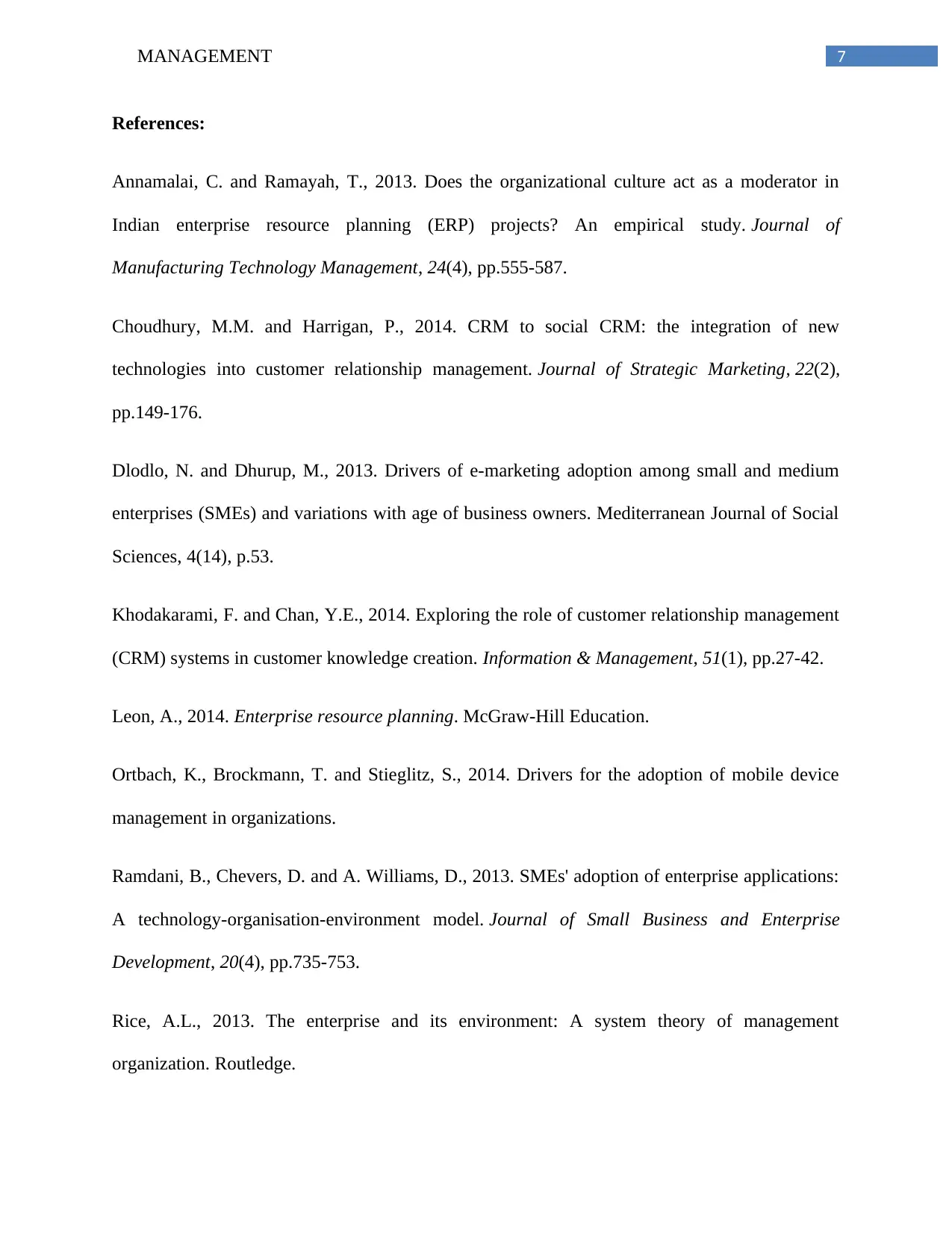
7MANAGEMENT
References:
Annamalai, C. and Ramayah, T., 2013. Does the organizational culture act as a moderator in
Indian enterprise resource planning (ERP) projects? An empirical study. Journal of
Manufacturing Technology Management, 24(4), pp.555-587.
Choudhury, M.M. and Harrigan, P., 2014. CRM to social CRM: the integration of new
technologies into customer relationship management. Journal of Strategic Marketing, 22(2),
pp.149-176.
Dlodlo, N. and Dhurup, M., 2013. Drivers of e-marketing adoption among small and medium
enterprises (SMEs) and variations with age of business owners. Mediterranean Journal of Social
Sciences, 4(14), p.53.
Khodakarami, F. and Chan, Y.E., 2014. Exploring the role of customer relationship management
(CRM) systems in customer knowledge creation. Information & Management, 51(1), pp.27-42.
Leon, A., 2014. Enterprise resource planning. McGraw-Hill Education.
Ortbach, K., Brockmann, T. and Stieglitz, S., 2014. Drivers for the adoption of mobile device
management in organizations.
Ramdani, B., Chevers, D. and A. Williams, D., 2013. SMEs' adoption of enterprise applications:
A technology-organisation-environment model. Journal of Small Business and Enterprise
Development, 20(4), pp.735-753.
Rice, A.L., 2013. The enterprise and its environment: A system theory of management
organization. Routledge.
References:
Annamalai, C. and Ramayah, T., 2013. Does the organizational culture act as a moderator in
Indian enterprise resource planning (ERP) projects? An empirical study. Journal of
Manufacturing Technology Management, 24(4), pp.555-587.
Choudhury, M.M. and Harrigan, P., 2014. CRM to social CRM: the integration of new
technologies into customer relationship management. Journal of Strategic Marketing, 22(2),
pp.149-176.
Dlodlo, N. and Dhurup, M., 2013. Drivers of e-marketing adoption among small and medium
enterprises (SMEs) and variations with age of business owners. Mediterranean Journal of Social
Sciences, 4(14), p.53.
Khodakarami, F. and Chan, Y.E., 2014. Exploring the role of customer relationship management
(CRM) systems in customer knowledge creation. Information & Management, 51(1), pp.27-42.
Leon, A., 2014. Enterprise resource planning. McGraw-Hill Education.
Ortbach, K., Brockmann, T. and Stieglitz, S., 2014. Drivers for the adoption of mobile device
management in organizations.
Ramdani, B., Chevers, D. and A. Williams, D., 2013. SMEs' adoption of enterprise applications:
A technology-organisation-environment model. Journal of Small Business and Enterprise
Development, 20(4), pp.735-753.
Rice, A.L., 2013. The enterprise and its environment: A system theory of management
organization. Routledge.
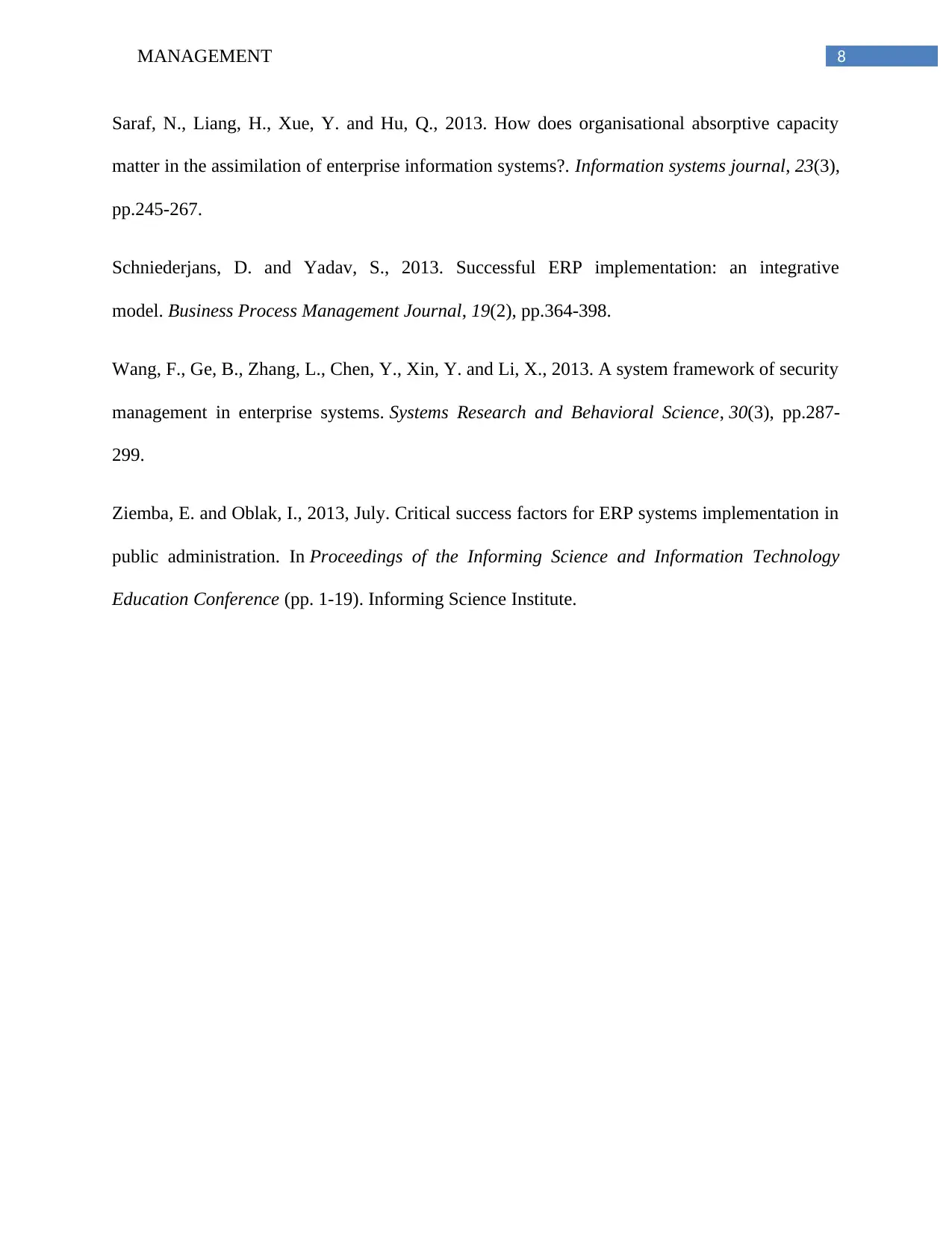
8MANAGEMENT
Saraf, N., Liang, H., Xue, Y. and Hu, Q., 2013. How does organisational absorptive capacity
matter in the assimilation of enterprise information systems?. Information systems journal, 23(3),
pp.245-267.
Schniederjans, D. and Yadav, S., 2013. Successful ERP implementation: an integrative
model. Business Process Management Journal, 19(2), pp.364-398.
Wang, F., Ge, B., Zhang, L., Chen, Y., Xin, Y. and Li, X., 2013. A system framework of security
management in enterprise systems. Systems Research and Behavioral Science, 30(3), pp.287-
299.
Ziemba, E. and Oblak, I., 2013, July. Critical success factors for ERP systems implementation in
public administration. In Proceedings of the Informing Science and Information Technology
Education Conference (pp. 1-19). Informing Science Institute.
Saraf, N., Liang, H., Xue, Y. and Hu, Q., 2013. How does organisational absorptive capacity
matter in the assimilation of enterprise information systems?. Information systems journal, 23(3),
pp.245-267.
Schniederjans, D. and Yadav, S., 2013. Successful ERP implementation: an integrative
model. Business Process Management Journal, 19(2), pp.364-398.
Wang, F., Ge, B., Zhang, L., Chen, Y., Xin, Y. and Li, X., 2013. A system framework of security
management in enterprise systems. Systems Research and Behavioral Science, 30(3), pp.287-
299.
Ziemba, E. and Oblak, I., 2013, July. Critical success factors for ERP systems implementation in
public administration. In Proceedings of the Informing Science and Information Technology
Education Conference (pp. 1-19). Informing Science Institute.
⊘ This is a preview!⊘
Do you want full access?
Subscribe today to unlock all pages.

Trusted by 1+ million students worldwide
1 out of 9
Related Documents
Your All-in-One AI-Powered Toolkit for Academic Success.
+13062052269
info@desklib.com
Available 24*7 on WhatsApp / Email
![[object Object]](/_next/static/media/star-bottom.7253800d.svg)
Unlock your academic potential
Copyright © 2020–2025 A2Z Services. All Rights Reserved. Developed and managed by ZUCOL.





